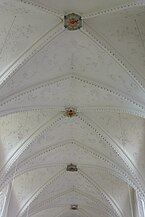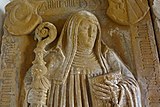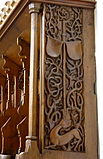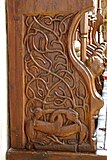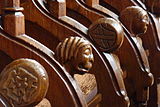Assumption of Mary (Kirchheim am Ries)
The Catholic parish church of the Assumption in Kirchheim am Ries , a community in the Ostalb district in Baden-Württemberg , was formerly the church of a Cistercian convent . The church was built around 1300 in the Gothic style and redesigned in Baroque style in the middle of the 17th and early 18th centuries . Gothic wall paintings and sculptures as well as the epitaphs of abbesses and the counts of Oettingen have been preserved in the church .
history
According to legend, Count Ludwig III. von Oettingen the Kirchheim monastery on the basis of a vow . While out hunting, he is said to have found himself in swampy terrain, which he only found out through prayers and the promise to build a monastery on the site. A deed of foundation from 1270 confirms the establishment of the monastery, which was attached to the Cistercian order. Count Ludwig III. and his sons, Konrad III. and Ludwig V, furnished it with goods and made it their home monastery and the burial place of their family. In 1273 Pope Gregory X issued an ecclesiastical letter of protection for the monastery. In another letter of protection from 1274, Rudolf von Habsburg confirmed the independence of the monastery. In 1275 it received the patronage right from the Counts of Oettingen for the two parish churches St. Martin and St. Jakob in Kirchheim. In 1296 the monastery already consisted of 50 nuns . 1307, the two churches of St. Martin and St. James were in the monastery incorporated . Despite the introduction of the Reformation in Kirchheim in 1553, the monastery remained Catholic.
In 1662 the interior of the church began to be redesigned in Baroque style , and in 1720 it was redesigned again. In the course of secularization , the monastery came first to the Princely House of Oettingen-Wallerstein in 1802 and then to the Kingdom of Bavaria in 1806 , before being incorporated into the Kingdom of Württemberg in 1810 . The last nuns who remained when the monastery was closed (an abbess, nine choir sisters, 17 lay sisters and six novices ) were allowed to continue living in the monastery and received an extinction pension . The last Cistercian woman died in 1858. In 1870 parts of the monastery buildings were demolished, such as the two-story cloister . The monastery church was preserved and has been used as a parish church since 1817. In 1995 the outside of the church was restored and in 1999 the inside was renovated.
architecture
Exterior construction
As is usual for Cistercian churches, the building does not have a tower, but is crowned by a modest roof turret on the west facade. The walls are divided into narrow pointed arch windows and buttresses .
inner space
The single-nave nave is covered by a ribbed vault, the four western yokes of which are richly decorated with stucco . This was carried out in 1720 and is attributed to Hans Georg Vogl , who belongs to the Wessobrunn school . The four western yokes were occupied by the nuns' gallery until 1831 , which was later reduced in size. In the heyday up to 70 sisters lived in the monastery.
The choir with a five-eighth closing is broken through by large tracery windows.
Epitaphs in the choir
A memorial plaque next to the pulpit from 1663 reports on the founding of the monastery on St. Urban Day in 1267 by Count Ludwig III. von Oettingen and his wife Adelheid von Hirschberg. The text shows that up to the Reformation 35 counts and 37 countesses from the House of Oettingen were buried in the monastery church. To the left of the high altar, two epitaphs commemorate the founders of the monastery. A male and a female figure are shown with a model of a church in hand. The stone slabs are the lids of chest graves that were set into the wall of the choir in 1662. On the right side of the high altar is the epitaph for Louis XI. von Oettingen , who is depicted with armor and sword. He held the post of court master under the emperor Sigismund and died in 1440.
Stephanskapelle
The Stephanskapelle, which presumably served as the burial place of the abbesses, adjoins the gallery . The room has a Gothic altar ciborium with Gothic wall paintings in the spandrels, which are also continued on the upper part of the wall. The scenes depict St. Martin sharing his cloak with a beggar in the right gusset , and the adoration of the Magi in the left gusset . The frescoes on the wall to the nave depict the coronation of Mary, the stoning of St. Stephen and St. Christopher .
Epitaphs in the St. Stephen's Chapel
The epitaphs of Margaretha von Oettingen (abbess from 1505 to 1535), Anna von Wöllwart (abbess from 1545 to 1553) Magdalena Geisberger (abbess from 1553 to 1560) and Apollonia Schrötl (abbess from 1584 to 1631) are placed on the walls. Next to the entrance to the church is the no longer completely preserved epitaph of Count Friedrich III. von Oettingen († 1423) and his wife Elisabeth († 1395), the upper part of which is provided with a crucifixion group.
Minster chapel
The sacristy and the minster chapel are built onto the north facade of the church . The chapel has a filigree ribbed vault with coats of arms and a rococo altar , the year of which is indicated by an inscription cartouche with the year 1742. In the altar extract, God the Father and the Holy Spirit are represented in the form of a dove. The figures on the side represent St. Joseph (left) and St. Anthony of Padua (right). The center of the altar is a Vespers , a Pietà made of stone , created in the early 15th century in the so-called soft style . Next to the altar is a dungeon Christian from the 18th century in a barred niche. Next to the baptismal font is a life-size figure of John the Baptist .
Further equipment
- In the Württemberg State Museum there is a valuable reliquary cross, the Count Ludwig XI. von Oettingen donated to the monastery.
- Late Gothic sculptures have been preserved in the church, such as the wooden relief of a coronation of the Virgin Mary and Anna herself , surrounded by baroque figures of saints.
- The pulpit and the two side altars date from around 1662/63 .
- The left altarpiece with the depiction of the Adoration of the Shepherds was made in 1672 by Johann Pichler. It is surrounded by the parents of Mary , St. Anna and St. Joachim . On the top of the altar stands Saint Joseph, who is accompanied by angels. Around 1713 the reliquary of the martyr Seraphia was built into the altar .
- The right altarpiece shows the crucifixion of Christ. On the side are the figures of the apostles Peter and Paul and on the altar crown the figure of St. Bernard of Clairvaux . The baroque shrine contains the relics of the martyr Clement .
- The high altar was made in 1756 in Kaisheim Monastery by the conversant Michael Schmid in 1756. The two almost life-size figures depict St. Benedict of Nursia , the author of the Benedictine Rule , and St. Bernard of Clairvaux , who significantly influenced the Cistercian order. Benedict of Nursia holds a cracked poison cup in his hand and Bernhard of Clairvaux carries it the instruments of Christ's passion . An angel sucking honey refers to his title Doctor mellifluus ("honey-flowing teacher"). The late Gothic Madonna in the altar niche is depicted as the Queen of Heaven, the baby Jesus in her arm, with a scepter in his hand, standing on a crescent moon and surrounded by a halo.
Choir stalls
The choir has Gothic choir stalls that are richly carved.
organ
Today's organ was installed in 1963 by the Späth brothers' organ building company from Mengen .
literature
- Edwin Michler: Monastery of the Assumption of Mary in Kirchheim am Ries . Kunstverlag Josef Fink, Lindenberg 2006, ISBN 3-89870-268-5 .
- Jochen Ansel, Anke Lorenz, Gabriele Schrade: “Adored to the most beautiful and dearest of all”. The "Infant Jesus of Prague" from the monastery church of the Assumption in Kirchheim am Ries . In: Denkmalpflege in Baden-Württemberg , 43rd year 2014, issue 1, pp. 26–32 ( PDF ).
- Ulrich Knapp: Monastery Church of the Assumption of the Virgin Mary in Kirchheim, Ries. Observations on building history. Rieser Kulturtage 10, 1995, 430–477.
Web links
- Cistercian monastery of the Assumption of the Virgin Mary Mayor's office in Kirchheim am Ries
Individual evidence
Coordinates: 48 ° 52 ′ 36.8 " N , 10 ° 23 ′ 51.1" E




